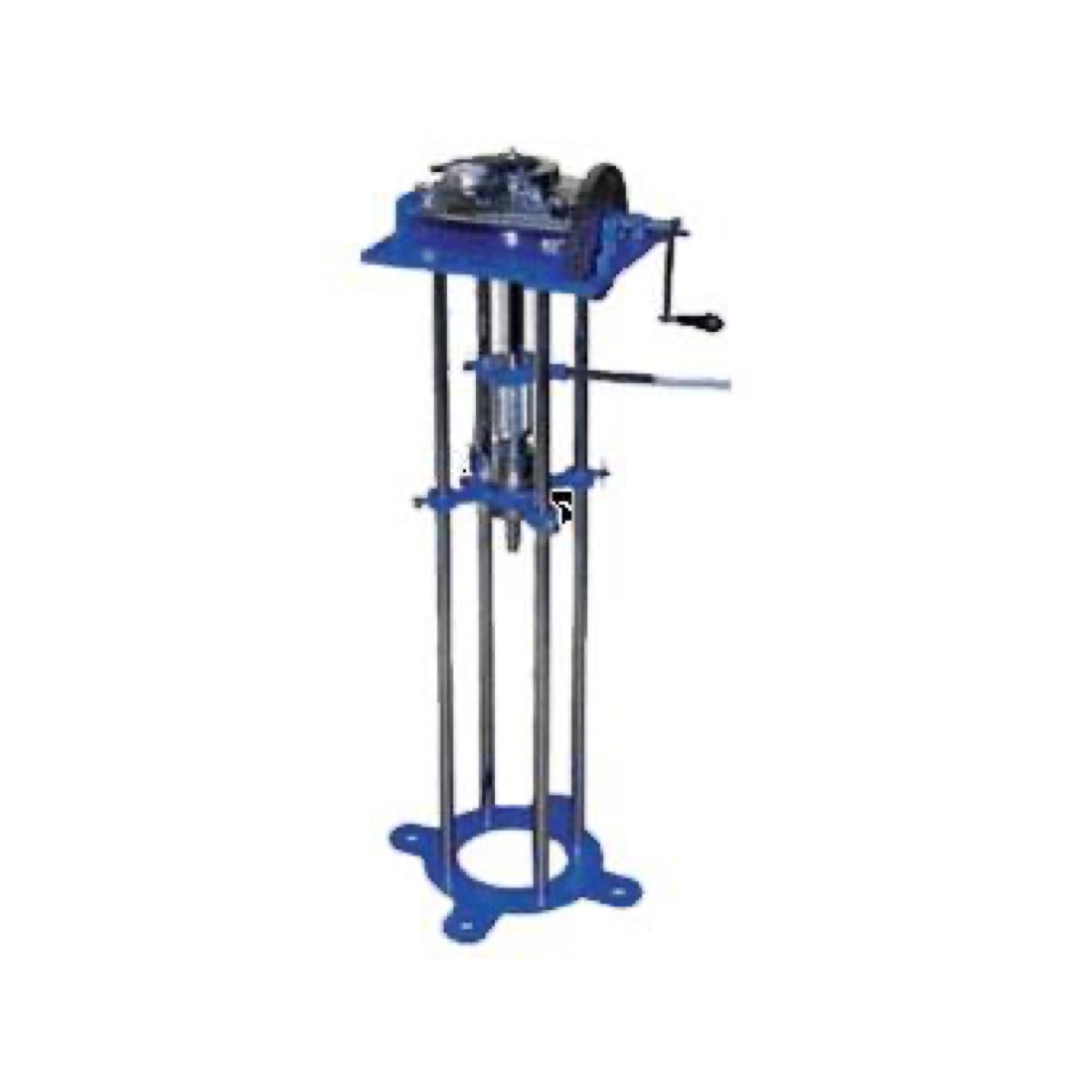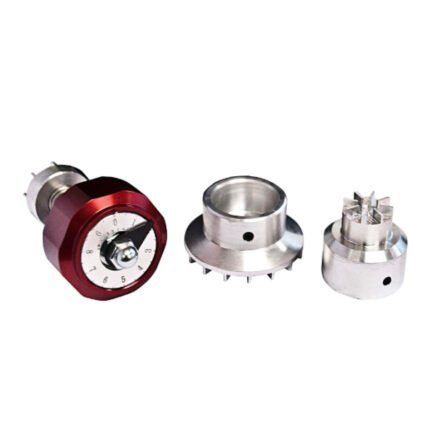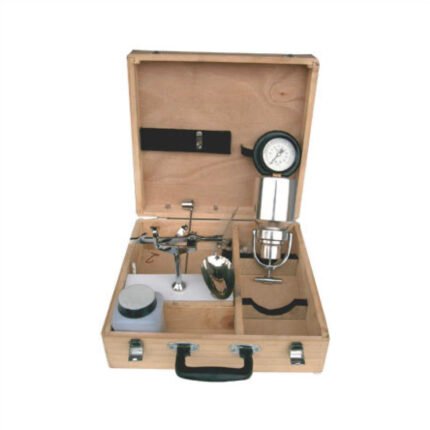AZA 0922 IN-SITU VANE SHEAR TEST
- AZA 0922 In-Situ Vane Shear Test: Field apparatus for cohesive soil strength.
- Directly measures undrained shear strength (c_u) of soft to medium clays.
- Minimizes sample disturbance for accurate in-situ results.
- Includes robust torque applicator with calibrated proving ring and dial gauge.
- Supplied with standard vane sizes (37.5x75mm, 50x100mm) and extension rods.
- Conforms to IS 4434, ASTM D2573, and ISO 22476-9 standards.
- Portable, durable, and essential for geotechnical site investigations.
- Enables determination of soil sensitivity
Description
AZA 0922 In-Situ Vane Shear Test Apparatus: Reliable Determination of Soil Strength in the Field by Azalab
The Azalab AZA 0922 In-Situ Vane Shear Test apparatus is a specialized and essential piece of equipment for geotechnical engineers and geologists conducting site investigations. It is designed for directly measuring the undrained shear strength (c_u) of soft to medium cohesive soils (clays and silts) in their natural, undisturbed state. This method is particularly vital in situations where obtaining high-quality undisturbed samples for laboratory testing is challenging or impossible, offering a quick, economical, and highly effective alternative for characterizing soil properties in the field. Its portability and robust design make it suitable for various project sites across India, from remote construction areas to urban geotechnical surveys.
Understanding the In-Situ Vane Shear Test and Its Principle
The In-Situ Vane Shear Test is a direct method to determine the undrained shear strength of sensitive and soft clays. The principle involves the following steps:
- Vane Insertion: A four-bladed, cruciform-shaped vane is carefully pushed into the saturated cohesive soil at the desired test depth, either from the ground surface or from the bottom of a pre-drilled borehole. The design ensures minimal disturbance to the surrounding soil during insertion.
- Torque Application: Once inserted, a constant rate of torque is applied to the vane through a string of rods from the surface. This is typically achieved using a calibrated torque head with a geared crank mechanism.
- Shear Failure & Measurement: As torque is applied, the vane rotates, causing a cylindrical surface of the soil around the vane to shear. The maximum torque required to cause this shear failure is meticulously measured. This peak torque corresponds to the undrained shear strength of the soil.
- Strength Calculation: The measured torque is then converted into undrained shear strength (c_u) using a specific formula that incorporates the dimensions of the vane (height and diameter) and the maximum torque value. The formula for undrained shear strength (c_u) is generally given by: c_u=fracT_maxK Where T_max is the maximum torque and K is a vane constant that depends on the vane dimensions (diameter D and height H). For a standard vane, K can be approximated by: K=fracpiD2H2left(1+fracD3Hright) or simpler K=piD2left(fracH2+fracD6right) (Note: Exact K-factor depends on the specific standard and vane design, typically provided with the equipment or standard.)
- Sensitivity Determination: After measuring the peak strength, the vane is often rotated rapidly (e.g., 5 to 10 revolutions) to completely remold the soil. A subsequent test is then performed to measure the remolded shear strength. The ratio of peak (undisturbed) shear strength to remolded shear strength provides the “sensitivity” of the clay, an important parameter for understanding soil behavior under disturbance.
Why Choose the AZA 0922 In-Situ Vane Shear Test?
The AZA 0922 In-Situ Vane Shear Test apparatus offers significant advantages for geotechnical investigations:
- Direct Measurement: Provides a direct and reliable measure of undrained shear strength in the field, reducing the need for laboratory tests on disturbed samples.
- Minimal Sample Disturbance: Compared to retrieving undisturbed samples, the in-situ test causes minimal disturbance to the soil, leading to more accurate representation of actual soil strength.
- Ideal for Soft/Sensitive Clays: Particularly effective for very soft, sensitive clays where obtaining truly undisturbed samples is extremely challenging or impossible.
- Cost-Effective & Rapid: A relatively quick and economical method for obtaining critical shear strength data on site, allowing for immediate engineering decisions.
- Portability: Designed for ease of transport and setup in various field conditions.
Key Features of the Azalab AZA 0922 In-Situ Vane Shear Test Apparatus: The AZA 0922 is built for precision, durability, and ease of use in demanding field environments:
- Robust Torque Applicator Assembly: Features a strong base-mounted torque applicator with a geared wheel and crank mechanism for smooth and controlled application of torque.
- Accurate Torque Measurement: Utilizes a calibrated split proving ring and a high-precision dial gauge (e.g., 0.002 x 5 mm) to accurately measure the applied torque. A calibration chart is supplied for converting dial gauge readings to torque force.
- Vane Blades: Includes standard cruciform vanes (e.g., 37.5 mm dia x 75 mm high and 50 mm dia x 100 mm high), fabricated from high-grade steel for durability and minimal soil disturbance.
- Extension Rods: Supplied with square cross-section torque rods (e.g., 0.6 m, 1 m, 1.5 m lengths) with quick-coupling or threaded connections, allowing for testing at various depths. Dummy rods are also provided to account for friction.
- Low Friction System: Incorporates thrust collars or bearings to minimize friction between the torque rods and guide casing/borehole walls, ensuring that the measured torque accurately reflects soil resistance.
- Rotation Indicator: A pointer or graduated scale is provided for registering the angle of rotation of the vane.
- Detachable Stand: A sturdy, detachable stand is included to anchor the instrument securely during testing.
- Portable Design: All components are designed for easy assembly, disassembly, and transport to diverse field sites.
Applications and Standards Compliance in India: The AZA 0922 In-Situ Vane Shear Test is extensively used in various geotechnical applications:
- Foundation Design: Critical for designing shallow and deep foundations (piles, rafts) on soft clay deposits.
- Embankment & Slope Stability: Assessing the stability of embankments, natural slopes, and excavations in cohesive soils.
- Retaining Structure Design: Providing strength parameters for the design of retaining walls and sheet pile structures.
- Dredging Operations: Characterizing the strength of dredged materials and soft sediments.
- Site Investigation: As part of comprehensive site investigations for infrastructure projects like roads, bridges, dams, and buildings.
The equipment is designed and manufactured to comply with key national and international standards, ensuring the reliability and acceptance of test results:
- IS 4434:1982 (Reaffirmed 2016): Indian Standard Method for Field Vane Shear Test for Cohesive Soil.
- ASTM D2573: Standard Test Method for Field Vane Shear Test in Cohesive Soil.
- ISO 22476-9: Geotechnical investigation and testing – Field testing – Part 9: Field vane test.
Azalab’s Commitment to Quality and Geotechnical Excellence: Azalab is committed to supplying high-quality, reliable geotechnical testing equipment that meets the stringent demands of the construction and research sectors in India. The AZA 0922 In-Situ Vane Shear Test apparatus stands as a testament to our dedication to providing precise instruments that empower engineers to make informed decisions based on accurate soil data. We ensure that our equipment is built to last, user-friendly, and fully compliant with relevant standards, supported by our comprehensive customer service.
Specifications:
- Model: AZA 0922
- Test Method: In-Situ Vane Shear Test (Field Vane Test)
- Application: Determination of Undrained Shear Strength (c_u) and Sensitivity of Saturated Cohesive Soils.
- Soil Type Suitability: Soft to medium cohesive soils (clays and silts).
- Torque Applicator Assembly:
- Capacity: Up to 2000 kgf.cm (approx. 200 N.m) or as per selected range.
- Measurement: Split proving ring with high-precision dial gauge (e.g., 0.002 x 5 mm or higher resolution).
- Operation: Geared crank for controlled rotation.
- Vanes (Cruciform):
- Standard Sizes Included:
- 37.5 mm diameter x 75 mm high (for stronger soils/higher strengths).
- 50.0 mm diameter x 100 mm high (for softer soils/lower strengths).
- Material: High-grade steel.
- H/D Ratio: Typically 2:1 as per standards.
- Standard Sizes Included:
- Torque Rods:
- Type: Square cross-section rods with quick-coupling or threaded connections.
- Lengths: Typically 0.6 m, 1.0 m, 1.5 m (or specified lengths for various depths).
- Number of Rods: Sufficient quantity to reach typical investigation depths.
- Friction Reduction: Equipped with appropriate bearings/thrust collars to minimize rod friction.
- Dummy Rods: Included, corresponding to vane sizes, for friction calibration.
- Rotation Indicator: Pointer or graduated scale for angular displacement measurement.
- Stand: Detachable, robust stand for anchoring the instrument.
- Construction: Heavy-duty, durable components suitable for field conditions.
- Carrying Case: Supplied with a sturdy wooden or durable carrying case for transport and protection.
- Standards Compliance: IS 4434:1982 (Reaffirmed 2016), ASTM D2573, ISO 22476-9.
- Country of Origin: Made in India.
FREQUENTLY ASKED QUESTIONS (FAQ):
- Q: What is the main purpose of the AZA 0922 In-Situ Vane Shear Test?
- A: It is used to directly measure the undrained shear strength (c_u) of soft to medium cohesive soils (clays and silts) in their natural, undisturbed state in the field.
- Q: Why is an in-situ test preferred over a laboratory test for certain soils?
- A: In-situ tests like the vane shear test minimize sample disturbance, which is crucial for soft, sensitive clays where obtaining truly undisturbed samples for laboratory testing is very difficult.
- Q: What kind of soils is this test suitable for?
- A: It is best suited for saturated cohesive soils, typically soft to medium consistency clays and silts. It is not suitable for sandy or gravelly soils.
- Q: How is the shear strength determined from the test?
- A: The apparatus measures the maximum torque required to cause shear failure in the soil. This torque, along with the dimensions of the vane, is used to calculate the undrained shear strength.
- Q: Does the equipment comply with Indian Standards?
- A: Yes, it is designed and supplied to comply with IS 4434:1982 (Reaffirmed 2016), as well as ASTM D2573.
- Q: Can it be used to determine soil sensitivity?
- A: Yes, by conducting tests on both undisturbed and fully remolded soil, the sensitivity of the clay can be calculated.
- Q: Is the AZA 0922 portable for field use?
- A: Yes, the apparatus is designed to be robust yet portable, making it suitable for field applications at various construction and investigation sites.
Additional information
| Model |
AZA 0922 |
|---|---|
| Test Method |
In-Situ Vane Shear Test (Field Vane Test) |
| Stand |
Detachable, robust stand for anchoring the instrument. |
| Construction |
Heavy-duty, durable components suitable for field conditions. |
| Country of Origin |
Made in India. |
| Standards Compliance |
IS 4434:1982 (Reaffirmed 2016), ASTM D2573, ISO 22476-9. |
Related products
AZA 0848 PLASTIC LIMIT SET
AZA 0849 SHRINKAGE LIMIT SET
- Used to determine shrinkage limit of cohesive soils
- Includes high-quality porcelain and stainless-steel tools
- Ideal for geotechnical engineering and soil mechanics labs
- Compact, easy to use, and conforms to IS 2720 standards
- Model: AZA 0849 – Durable and reliable build
- Supplied with a complete set for lab-ready use
AZA 0856 GRAIN SIZE ANALYSIS (PIPETTE METHOD)
- Grain size analysis using sedimentation and pipette method
- Ideal for determining particle distribution in fine soils
- Conforms to IS 2720 (Part 4) and ASTM D422
- Includes sedimentation cylinder, pipette, stand, timer
- Accurate and repeatable measurement of soil fractions
- Essential for geotechnical and soil mechanics labs
AZA 0865 HEAVY COMPACTION TEST
- Heavy Compaction Test: Specifically designed to perform the Modified Proctor Compaction Test.
- High Compaction Energy: Utilizes a heavier hammer and greater drop height for higher soil density requirements.
- Crucial for Critical Projects: Essential for quality control in heavy civil engineering applications like airfields and high-stress pavements.
- Complete Apparatus: Includes a robust compaction mould, heavy rammer, and necessary accessories.
- Standard Compliant: Adheres to international standards such as ASTM D1557 and equivalent IS/BS norms.
- Azalab Quality: Durable and precise equipment for reliable geotechnical testing results.
AZA 0871 WATER LEVEL INDICATOR
- Water Level Indicator: Essential instrument for accurate measurement of groundwater levels.
- Versatile Use: Ideal for monitoring water levels in boreholes, standpipes, wells, and observation tubes.
- Precise Detection: Features a sensitive probe that provides clear audible and visual indication upon contact with water.
- Graduated Cable: High-accuracy, durable cable with clear markings for precise depth readings.
- Portable & Robust: Designed for demanding field monitoring in environmental, hydrological, and geotechnical applications.
- Azalab Quality: Reliable and easy-to-use equipment for consistent groundwater monitoring.
AZA 0872 DYNAMIC CONE PENETROMETER
- Dynamic Cone Penetrometer (DCP): Essential for rapid in-situ testing of soil strength and compaction.
- Pavement Evaluation: Ideal for assessing subgrade, sub-base, and base course layers in road construction.
- Direct Readout: Provides immediate penetration resistance data, correlating to CBR values.
- Portable & User-Friendly: Lightweight and easy to operate, suitable for various field conditions.
- Robust Construction: Durable components for long-lasting performance in demanding geotechnical testing.
AZA 0874 RAPID MOISTURE METER
- Rapid Moisture Meter: Utilizes the calcium carbide method for quick determination of moisture content.
- Field-Ready: Ideal for field testing of soils, aggregates, sand, and fine materials.
- Portable & Self-Contained: No external power source required, perfect for on-site quality control.
- Immediate Results: Provides fast, accurate readings, enabling immediate adjustments.
- Durable Construction: Robust design suitable for demanding construction and geotechnical testing environments.
- Azalab Quality: Reliable and efficient tool for rapid soil moisture assessment.
AZA 0875 INFRARED MOISTURE METER
- Infrared Heating: Utilizes advanced infrared technology for rapid and uniform sample drying.
- Precise Measurement: Delivers highly accurate moisture content results in a fraction of the time.
- Versatile Application: Ideal for various materials including soils, aggregates, chemicals, food products, and more.
- User-Friendly: Features intuitive controls and a clear display for straightforward operation.
- Rapid Analysis: Significantly speeds up testing processes compared to conventional oven drying.
- Azalab Quality: Reliable and efficient instrument for critical quality control and material testing.

 Rock
Rock Aggregate
Aggregate Cement
Cement Concrete
Concrete Soil
Soil Steel
Steel Bitumen/Asphalt
Bitumen/Asphalt Security Survey Equipment
Security Survey Equipment General Items
General Items











